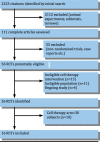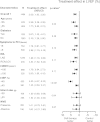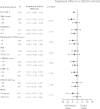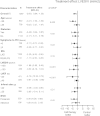Impact of intracoronary bone marrow cell therapy on left ventricular function in the setting of ST-segment elevation myocardial infarction: a collaborative meta-analysis
- PMID: 24026778
- PMCID: PMC4271100
- DOI: 10.1093/eurheartj/eht372
Impact of intracoronary bone marrow cell therapy on left ventricular function in the setting of ST-segment elevation myocardial infarction: a collaborative meta-analysis
Abstract
Aims: The objective of the present analysis was to systematically examine the effect of intracoronary bone marrow cell (BMC) therapy on left ventricular (LV) function after ST-segment elevation myocardial infarction in various subgroups of patients by performing a collaborative meta-analysis of randomized controlled trials.
Methods and results: We identified all randomized controlled trials comparing intracoronary BMC infusion as treatment for ST-segment elevation myocardial infarction. We contacted the principal investigator for each participating trial to provide summary data with regard to different pre-specified subgroups [age, diabetes mellitus, time from symptoms to percutaneous coronary intervention, infarct-related artery, LV end-diastolic volume index (EDVI), LV ejection fraction (EF), infarct size, presence of microvascular obstruction, timing of cell infusion, and injected cell number] and three different endpoints [change in LVEF, LVEDVI, and LV end-systolic volume index (ESVI)]. Data from 16 studies were combined including 1641 patients (984 cell therapy, 657 controls). The absolute improvement in LVEF was greater among BMC-treated patients compared with controls: [2.55% increase, 95% confidence interval (CI) 1.83-3.26, P < 0.001]. Cell therapy significantly reduced LVEDVI and LVESVI (-3.17 mL/m², 95% CI: -4.86 to -1.47, P < 0.001; -2.60 mL/m², 95% CI -3.84 to -1.35, P < 0.001, respectively). Treatment benefit in terms of LVEF improvement was more pronounced in younger patients (age <55, 3.38%, 95% CI: 2.36-4.39) compared with older patients (age ≥ 55 years, 1.77%, 95% CI: 0.80-2.74, P = 0.03). This heterogeneity in treatment effect was also observed with respect to the reduction in LVEDVI and LVESVI. Moreover, patients with baseline LVEF <40% derived more benefit from intracoronary BMC therapy. LVEF improvement was 5.30%, 95% CI: 4.27-6.33 in patients with LVEF <40% compared with 1.45%, 95% CI: 0.60 to 2.31 in LVEF ≥ 40%, P < 0.001. No clear interaction was observed between other subgroups and outcomes.
Conclusion: Intracoronary BMC infusion is associated with improvement of LV function and remodelling in patients after ST-segment elevation myocardial infarction. Younger patients and patients with a more severely depressed LVEF at baseline derived most benefit from this adjunctive therapy.
Keywords: Bone marrow cells; Meta-analysis; ST-segment elevation myocardial infarction; Ventricular function.
Figures




Comment in
-
Current clinical trials of cell-based therapies in cardiac repair: too many variables spoil the stem cell broth.Eur Heart J. 2014 Apr;35(15):955-7. doi: 10.1093/eurheartj/eht423. Epub 2013 Oct 11. Eur Heart J. 2014. PMID: 24122960 No abstract available.
Similar articles
-
Is the measurement of left ventricular ejection fraction the proper end point for cell therapy trials? An analysis of the effect of bone marrow mononuclear stem cell administration on left ventricular ejection fraction after ST-segment elevation myocardial infarction when evaluated by cardiac magnetic resonance imaging.Am Heart J. 2011 Oct;162(4):671-7. doi: 10.1016/j.ahj.2011.06.019. Am Heart J. 2011. PMID: 21982659 Review.
-
Bone Marrow Mononuclear Cells Transfer for Patients after ST-Elevated Myocardial Infarction: A Meta-Analysis of Randomized Control Trials.Yonsei Med J. 2018 Jul;59(5):611-623. doi: 10.3349/ymj.2018.59.5.611. Yonsei Med J. 2018. PMID: 29869459 Free PMC article.
-
Effect of intracoronary delivery of autologous bone marrow mononuclear cells 2 to 3 weeks following acute myocardial infarction on left ventricular function: the LateTIME randomized trial.JAMA. 2011 Nov 16;306(19):2110-9. doi: 10.1001/jama.2011.1670. Epub 2011 Nov 14. JAMA. 2011. PMID: 22084195 Free PMC article. Clinical Trial.
-
Effects of timing on intracoronary autologous bone marrow-derived cell transplantation in acute myocardial infarction: a meta-analysis of randomized controlled trials.Stem Cell Res Ther. 2017 Oct 16;8(1):231. doi: 10.1186/s13287-017-0680-5. Stem Cell Res Ther. 2017. PMID: 29037256 Free PMC article.
-
Impact of intracoronary cell therapy on left ventricular function in the setting of acute myocardial infarction: a meta-analysis of randomised controlled clinical trials.Heart. 2013 Feb;99(4):225-32. doi: 10.1136/heartjnl-2012-302230. Epub 2012 Aug 8. Heart. 2013. PMID: 22875736 Review.
Cited by
-
Bone marrow mononuclear cell therapy for acute myocardial infarction: a perspective from the cardiovascular cell therapy research network.Circ Res. 2014 May 9;114(10):1564-8. doi: 10.1161/CIRCRESAHA.114.303720. Circ Res. 2014. PMID: 24812350 Free PMC article. Review.
-
Novel Approaches to Program Cells to Differentiate into Cardiomyocytes in Myocardial Regeneration.Rev Cardiovasc Med. 2022 Nov 30;23(12):392. doi: 10.31083/j.rcm2312392. eCollection 2022 Dec. Rev Cardiovasc Med. 2022. PMID: 39076655 Free PMC article. Review.
-
Consistently Inconsistent-Bone Marrow Mononuclear Stem Cell Therapy Following Acute Myocardial Infarction: A Decade Later.Circ Res. 2016 Jul 22;119(3):404-6. doi: 10.1161/CIRCRESAHA.116.309231. Circ Res. 2016. PMID: 27458193 Free PMC article. No abstract available.
-
Myeloid-derived growth factor (C19orf10) mediates cardiac repair following myocardial infarction.Nat Med. 2015 Feb;21(2):140-9. doi: 10.1038/nm.3778. Epub 2015 Jan 12. Nat Med. 2015. PMID: 25581518
-
Therapeutic Use of Stem Cells for Myocardial Infarction.Bioengineering (Basel). 2018 Apr 6;5(2):28. doi: 10.3390/bioengineering5020028. Bioengineering (Basel). 2018. PMID: 29642402 Free PMC article. Review.
References
-
- Lipinski MJ, Biondi-Zoccai GG, Abbate A, Khianey R, Sheiban I, Bartunek J, Vanderheyden M, Kim HS, Kang HJ, Strauer BE, Vetrovec GW. Impact of intracoronary cell therapy on left ventricular function in the setting of acute myocardial infarction: a collaborative systematic review and meta-analysis of controlled clinical trials. J Am Coll Cardiol. 2007;50:1761–1767. - PubMed
-
- Martin-Rendon E, Brunskill SJ, Hyde CJ, Stanworth SJ, Mathur A, Watt SM. Autologous bone marrow stem cells to treat acute myocardial infarction: a systematic review. Eur Heart J. 2008;29:1807–1818. - PubMed
-
- Dill T, Schachinger V, Rolf A, Mollmann S, Thiele H, Tillmanns H, Assmus B, Dimmeler S, Zeiher AM, Hamm C. Intracoronary administration of bone marrow-derived progenitor cells improves left ventricular function in patients at risk for adverse remodeling after acute ST-segment elevation myocardial infarction: results of the Reinfusion of Enriched Progenitor cells And Infarct Remodeling in Acute Myocardial Infarction study (REPAIR-AMI) cardiac magnetic resonance imaging substudy. Am Heart J. 2009;157:541–547. - PubMed
-
- Meyer GP, Wollert KC, Lotz J, Pirr J, Rager U, Lippolt P, Hahn A, Fichtner S, Schaefer A, Arseniev L, Ganser A, Drexler H. Intracoronary bone marrow cell transfer after myocardial infarction: 5-year follow-up from the randomized-controlled BOOST trial. Eur Heart J. 2009;30:2978–2984. - PubMed
-
- Tendera M, Wojakowski W, Ruzyllo W, Chojnowska L, Kepka C, Tracz W, Musialek P, Piwowarska W, Nessler J, Buszman P, Grajek S, Breborowicz P, Majka M, Ratajczak MZ. Intracoronary infusion of bone marrow-derived selected CD34+CXCR4+ cells and non-selected mononuclear cells in patients with acute STEMI and reduced left ventricular ejection fraction: results of randomized, multicentre Myocardial Regeneration by Intracoronary Infusion of Selected Population of Stem Cells in Acute Myocardial Infarction (REGENT) Trial. Eur Heart J. 2009;30:1313–1321. - PubMed
Publication types
MeSH terms
Grants and funding
LinkOut - more resources
Full Text Sources
Other Literature Sources
Medical

